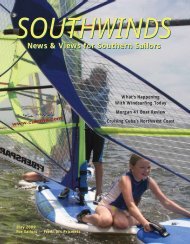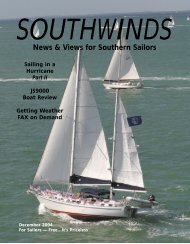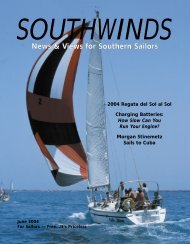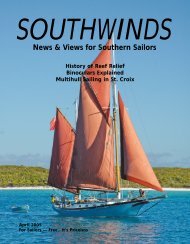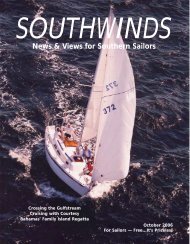CAROLINA SAILINGForty is the New...ThingBy Dan DickisonOccasional Charlestonians Tim Fetsch (on the helm) and BenPoucher (crewing), comprise Icarus Racing, a game, if low-budgetentry, in the Atlantic Cup 2012. Photo courtesy Atlantic Cup 2012.May in the Carolina Low Country is something of ametronome <strong>for</strong> sailors. In these parts, this month ismarked by particular beats. There’s the northerlymigration of cruisers up the ICW at one end, and then theneedle swings to the beginning of warm-weather sailing atthe other. There’s the Charleston Ocean RacingAssociation’s Femme Fatale, and then there’s the MemorialDay regatta <strong>for</strong> the Sea Island One-Design fleet. And so theneedle swings, back and <strong>for</strong>th. On the even years, there’s theGulfstreamer Race from Daytona Beach, FL, to Charleston,and on the odd years, there’s the 777-mile Charleston-to-Bermuda Race. But this May, the metronome is changingtempo a bit. For sailors around Charleston, this will be themonth of the 40s—the Class 40s.Based on a concept dating to 2004, Class 40s are thesmaller, less costly siblings of Open 60 racing sailboats, andlike their larger relations, they are designed and builtexpressly <strong>for</strong> open-ocean, shorthanded competition. Theirhallmarks include large, powerful sail plans and broad, primarilyflat hulls with good <strong>for</strong>m stability. To keep costsdown, class rules stipulate that exotic materials such as carbonfiber are only allowed in the spars. In addition, the keelsmust be fixed, not canting, and the metals used in the boatcannot be exotic (no titanium, etc.). Further, the sail inventoriesare strictly controlled. And the overall conceptappears to be succeeding. To date, nearly 100 Class 40 boatshave been built, with the majority of them active in Europe.But the concept is gradually taking root in the United States.Some time in early May, Class 40 boats will beginappearing in Charleston Harbor, because this is the finishport <strong>for</strong> leg IV of the Global Ocean Race, an arduous, fivelegcontest around the planet. When it started lastSeptember in Mallorca, Spain, there were seven entries, butit has evolved to become a four-boat contest due to the attritionthat is characteristic of such globe-girdling events. Thefour teams will spend a couple of weeks here, and thenresume racing when the Global Ocean Race restarts inCharleston on Sunday, May 20.While the crews of those four boats go about prepping<strong>for</strong> the final leg of their event, another crop of Class 40s willalready have been popping up in marinas and boatyardsaround the Holy City. These other Class 40s make up thefleet of the Atlantic Cup 2012, an event scheduled to start inCharleston Harbor on Friday, May 11.The Atlantic Cup 2012—in just its second year of existence—isa three-stage affair that features two double-handeddistance legs—from Charleston to New York, and then40 May 2012 SOUTHWINDS www.southwindsmagazine.com
Frenchmen Jacques Fornier and J.C. Caso, on board Groupe Picoty,are among the most experienced doubled-handed duo in theAtlantic Cup 2012 and odds-on favorites. Photo courtesy AtlanticCup 2012.from the Big Apple to Newport, RI—followed by a series offully crewed, around-the-buoys-style contests in Newport.It’s conceivable that the fleet participating in the AtlanticCup 2012 could include up to 12 entries, which would make<strong>for</strong> a spectacular sight at the start on that Friday. Equallyencouraging <strong>for</strong> Class 40 enthusiasts in the United States isthat the fleet includes five entries from this country. Amongthose is the Charleston-based duo of Tim Fetsch and BenPoucher competing on board Icarus Racing. These two professionalsailors are using the Class 40 (and the Atlantic Cup2012) as a means of making inroads into sponsored sailing.“The whole point of the Atlantic Cup is to create a plat<strong>for</strong>m<strong>for</strong> sailors and sponsors to have a voice,” explainedFetsch. “There are other races out there that provide such aCharleston Sailing School“Learn to Sail with Confidence”Sailing LessonsBareboat & Skippered ChartersPowerboat RentalsYacht DeliveriesCharleston City Marina • 17 Lockwood Dr.843-364-4123www.charlestonsailingschool.comAt the start of leg IV of the double-handed Global Ocean Race, thefleet had diminished to just four entries, but the action remainedtight. Photo courtesy Global Ocean Race.plat<strong>for</strong>m—the Volvo Ocean Race, the America’s Cup, etc.—but the majority of them are out of reach <strong>for</strong> most sailors.And other events, such as the Newport Bermuda Race,don’t really pursue exposure in the way that sponsors needit…The guys who organized the Atlantic Cup—11 th HourRacing—are friends of ours and they got us excited about it.So, we participated last year, but just barely.”Fetsch and Poucher spent months searching <strong>for</strong> a sponsorprior to that inaugural Atlantic Cup. Two weeks be<strong>for</strong>ethe race was to start, they didn’t have a boat or a main sponsor,but then Ralf Steitz, the president of the U.S. MerchantMarines Sailing Foundation, offered to loan them a Class 40that had recently been donated to the foundation. On a barebonesbudget, and an agreement that Fetsch describes as“built on trust and sheer enthusiasm,” they made a go of it,ultimately finishing second in the inshore races and fourthin the offshore leg out of a total of four entries. They didn’ttake home any of the $15,000 in prize money, but they didgarner important experience.“Ben and I are both well-employed as professionalsailors. We manage racing boats <strong>for</strong> our clients. We race withthem and we also deliver boats, and we’re <strong>for</strong>tunate becausethe phone is ringing a lot these days. We knew we could dothose jobs <strong>for</strong> the <strong>for</strong>eseeable future, so we asked ourselves‘what’s stopping us from doing something different, somethingthat could help make the point that, given the rightplat<strong>for</strong>m, sponsored sailing could really work in the U.S.market?’ That’s why we’re involved in the Class 40 arena.”Fetsch says that he and Poucher have been getting excitedin the past couple of months about this event. “We’re seeingthe Atlantic Cup gain traction. There’s a strong possibilityof 12 boats competing this year, with a fairly internationalfleet. What’s cool <strong>for</strong> us is that we’ll be competing on board aboat designed and built in the U.S. What are our chances?Well, I think we’re going to be competitive. It’s apt to be areally competitive fleet, and we’ve only sailed one event thatmatched the boat up against other Class 40s, but we’ve spenta lot more time on the boat since then and we think it’s reallystrong upwind and pretty good reaching. We’re a little concernedabout our downwind speed, but there are a lot of factorsin a varied event like this, so we’ll see.”At least one outcome is clear. This May, Fetsch and Poucherwill be helping to make a statement about the viability of sponsoredsailing in the United States, one way or the other.Go to www.globaloceanrace.com <strong>for</strong> in<strong>for</strong>mation on the GlobalOcean Race. For the Atlantic Cup ’12, go to www.atlanticup.org.<strong>News</strong> & <strong>Views</strong> <strong>for</strong> <strong>Southern</strong> <strong>Sailors</strong> SOUTHWINDS May 2012 41
- Page 3: TURNER MARINE YACHT SALESMobile, AL
- Page 6 and 7: SOUTHWINDSNEWS & VIEWS FOR SOUTHERN
- Page 8 and 9: SOUTHWINDSNews & Views For Southern
- Page 10 and 11: FROM THE HELMSTEVE MORRELL, EDITORP
- Page 12 and 13: LETTERSlocal officials could be rem
- Page 14 and 15: Bubba Clears Up Youth Sailing Conun
- Page 16 and 17: EVENTS & NEWS OF INTEREST TO SOUTHE
- Page 18: May 14-18. Offshore Sailing School,
- Page 21 and 22: the extensive docks at The Club. Bo
- Page 23 and 24: Ethanol and Old OutboardBoat Engine
- Page 25 and 26: To Advertise, call 941-795-8704 or
- Page 27 and 28: To Advertise, call 941-795-8704 or
- Page 29 and 30: To Advertise, call 941-795-8704 or
- Page 31 and 32: shall unreasonably or unnecessarily
- Page 33 and 34: SMALL BOAT REVIEWThe HamptonBy Jabb
- Page 35 and 36: Hampton sailors range in age from t
- Page 37 and 38: ST. PETERSBURG MUNICIPAL MARINAFLOR
- Page 39 and 40: BOATOWNER’S BOAT REVIEWSeaPearl 2
- Page 41: The SeaPearl Tri-Sport can be order
- Page 45 and 46: Bill and Sherry Welch of Useppa and
- Page 47 and 48: in gyms and raced Snipesagainst men
- Page 49 and 50: Mills’ yard in the 1950s, Clearwa
- Page 51 and 52: RACING■ SOUTHERN REGIONAL RACINGT
- Page 53 and 54: 59th Annual Mug Race, The RudderClu
- Page 55 and 56: Sailing in the Sarasota Sailing Squ
- Page 57 and 58: holds its opening day ceremonies an
- Page 59 and 60: Performance CruisingSabre 456, 426,
- Page 61 and 62: “Making Dreams Come True”Servin
- Page 63 and 64: CLASSIFIED ADSAds Starting at 3 Mon
- Page 65 and 66: CLASSIFIED ADS34’ Gemini 105C 200
- Page 67 and 68: CLASSIFIED ADS2002 Beneteau First 4
- Page 69 and 70: March 2012CLASSIFIED ADSHELP WANTED
- Page 71 and 72: ADVERTISER’S CATEGORIESTELL THEM



